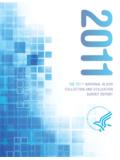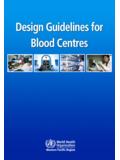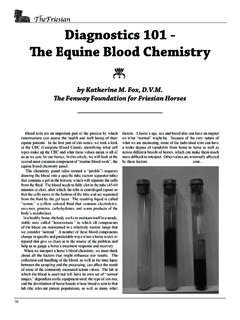Transcription of National Healthcare Safety Network (NHSN) Surveillance ...
1 Life After NNIS: National Healthcare Safety Network ( nhsn ) Surveillance Definitions: Central Line Associated Bloodstream Infection (CLABSI) & Related Sites. Select Site Definitions: Primary bloodstream infections are classified according to the criteria used, either as laboratory-confirmed bloodstream infection (LCBI) or clinical sepsis (CSEP).[CSEP is used to report only a primary BSI in neonates (< 30 days old) and infants (< 1 year old)-Definitions that follow refer only to Adults.] Report only those events that are with the nursing care area/ICU where the patient was at the point of onset of the BSI and are central line-associated (a central line was in place at the time of, or within 48 hours before, onset of the event). If the BSI develops in a patient within 48 hours of discharge from a location, indicate the discharging location on the CLABSI case report, not the current location of the patient.
2 Examples: i) Central line was inserted on day of admission for a patient in the Emergency Department who was then transferred to SICU. On day 5 the patient develops CLABSI while in the SICU therefore the unit to which this is attributed is SICU. ii) Central line, a PICC, is inserted in the MICU on day of admission. After day 4 the patient is stable and is discharged to Progressive Care unit (PCU). On day 5 the patient develops CLABSI. The unit to which this is attributed is MICU. Central line: A vascular infusion device that terminates at or close to the heart or in one of the great vessels. The following are considered great vessels for the purpose of reporting central-line associated infections and counting central-line days: Aorta, pulmonary artery, superior vena cava, inferior vena cava, brachiocephalic veins, internal jugular veins, subclavian veins, external iliac veins, and common femoral veins.
3 NOTE: Neither the location of the insertion site nor the type of device may be used to determine if a line qualifies as a central line. The device must terminate in one of these vessels or in or near the heart and be used for infusion to qualify as a central line. NOTE: Pacemaker wires and other noninfusion devices inserted into central blood vessels or the heart are not considered central lines. Temporary Central Line: A central line that is uncuffed and not tunneled Permanent Central Line: A central line that is cuffed and tunneled. Excerpts from source materials kindly provided by nhsn , Div. Of Healthcare Quality Promotion, CDC. Developed by MHA-KICU Infectious Disease Advisory Group. Final 06_2006 1 Excerpts from source materials kindly provided by nhsn , Div.
4 Of Healthcare Quality Promotion, CDC. Developed by MHA-KICU Infectious Disease Advisory Group. Final 06_2006 2 Laboratory-confirmed bloodstream infection (LCBI) LCBI criteria may be used for all patients. LCBI must meet one of the following three criteria: Criterion 1: Patient has a recognized pathogen cultured from one or more blood cultures and organism cultured from blood is not related to an infection at another site. Criterion 2: Patient has at least one of the following signs or symptoms: fever (>380 C), chills, or hypotension and signs and symptoms and positive laboratory results are not related to an infection at another site and at least one of the following: a. common skin contaminant ( , diphtheroids, Bacillus sp., Propionibacterium sp.)
5 , coagulase-negative staphylococci, or micrococci) is cultured from two or more blood cultures drawn on separate occasions. b. common skin contaminant ( , diphtheroids, Bacillus sp., Propionibacterium sp., coagulase-negative staphylococci, or micrococci) is cultured from at least one blood culture from a patient with an intravascular line, and the physician institutes appropriate antimicrobial therapy. c. positive antigen test on blood ( , H. influenzae, S. pneumoniae, N. meningitidis, or Group B Streptococcus). Denominator Data: Denominator data, central line days that are collected differ according to the location of the patients being monitored. For ICUs and locations other than specialty care areas and NICUs, the number of patients with one or more central lines of any type is collected daily, ideally at the about the same time each day, and then summed and the total is reported for the month on the Device Denominator for Intensive Care Unit (ICU)/Other Locations Data Collection Form.
6 See also FAQs for more on collection of central line days. For specialty care areas (SCAs), the number of patients with one or more central lines is dichotomized into those with permanent (tunneled/cuffed) central lines and those with temporary (nontunneled/noncuffed) central lines on the Denominators for Specialty Care Area (CDC ). Each is collected daily, at the same time each day, summed and the total for each is reported for the month. This distinction is made because permanent/tunneled and cuffed lines are commonly used in patients frequenting these areas and may have lower rates of associated infection than nontunneled and noncuffed central lines inserted for temporary use. If a patient has both a temporary and a permanent central line, only the temporary line is counted.
7 Data Analyses: The CLABSI rate per 1000 central line-days is calculated by dividing the number of CLABSI by the number of central line-days and multiplying the result by 1000 (see example below) . The Central Line utilization Ratio is calculated by dividing the number of central line-days by the number of patient-days.(see example below) These calculations should be performed separately for different types of ICUs, specialty care areas, and other locations in the institution. Example of CLABSI Rate Calculation: Example of CL utilization Ratio: [Source: CDC. AJIC 2004;32:470-85]- Device associated infection : An infection in a patient with a device ( , ventilator or central line) that was used within the 48-hour period before onset of infection.
8 If the interval is longer than 48 hours, there must be compelling evidence that the infection was associated with device use. Localized Infection for Central Line insertion site: Arterial or venous infection CODE: Cardiovascular system arterial or venous infection (CVS-VASC) Definition: Arterial or venous infection must meet at least one of the following criteria: Criterion 1: Patient has organisms cultured from arteries or veins removed during a surgical operation and blood culture not done or no organisms cultured from blood. Criterion 2: Patient has evidence of arterial or venous infection seen during a surgical operation or histopathologic examination. Criterion 3: Patient has at least one of the following signs or symptoms with no other recognized cause: fever, (>38 0C), pain, erythema, or heat at involved vascular site and more than 15 colonies cultured from intravascular cannula tip using semiquantitative culture method and blood culture not done or no organisms cultured from blood.
9 Criterion 4: Patient has purulent drainage at involved vascular site and blood culture not done or no organisms cultured from blood. Excerpts from source materials kindly provided by nhsn , Div. Of Healthcare Quality Promotion, CDC. Developed by MHA-KICU Infectious Disease Advisory Group. Final 06_2006 3 Excerpts from source materials kindly provided by nhsn , Div. Of Healthcare Quality Promotion, CDC. Developed by MHA-KICU Infectious Disease Advisory Group. Final 06_2006 4 CVS-VASC Issues: Report infections of an arteriovenous graft, shunt, or fistula or intravascular cannulation site without organisms cultured from blood as CVS-VASC. Report intravascular infections with organisms cultured from the blood as BSI-LCBI Report purulent phlebitis confirmed with a positive semiquantitative culture of a catheter tip, but with either negative or no blood culture, as CVS-VASC.
10 Report organisms cultured from blood as BSI-LCBI when no other site of infection is evident. Pseudobacteremias, meaning contaminants introduced into the blood culture during incubation example: blood culture machine malfunction introduces microbes into blood culture bottle during analysis - are not Healthcare -associated infections.





